● Audi RS brand logo: Abbreviation of “RennSport”


Before introducing the Audi RS, let’s take a look at the RS logo. “RS” is actually the acronym for “RennSport” in German, which is literally translated into “racing sport” in English. The “RS” series is the highest performance product in the Audi family. It can be said that it is the display platform of Audi’s top technology, and it is usually produced in a limited way. The RS logo is very simple and clear. It only uses RS letters and a red base, and red stands for performance. The overall feel is very low-key.
● Audi quattro company: the founder of the Audi RS model (1983-present)
To introduce RS, we have to mention Audi’s racing division, quattro Ltd., because Audi RS was developed and built by quattro Ltd. quattro Co., Ltd. was established in 1983 and was primarily responsible for the development of high-performance personal customization and accessories. The company’s name was to pay tribute to the rally cars built on the Audi Quattro at the time. In order to distinguish it from the vehicle model, the first letter is intentionally changed to lowercase “q”.

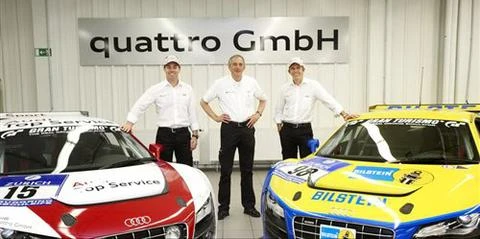
quattro ltd. is located in Neckarsulm, near Stuttgart, Germany. Although the company has its own trademark right, “quattro GmbH”, it does not have the right to produce and sell cars directly under this brand name. It must be under the Audi name. However, it can sell some exclusive designed daily necessities and accessories under the brand “quattro GmbH” through franchised dealers.

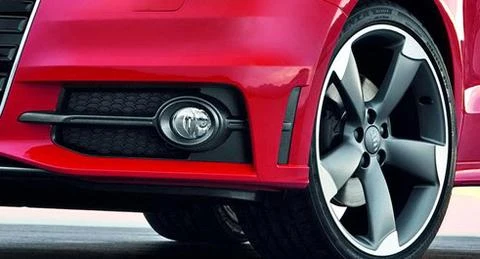
The main business of Audi quattro is to create high-performance models and accessories for Audi, as well as customized models for customers. At present, the products produced by Audi quattro mainly include Audi S line kit, Audi S series and Audi RS series. Performance R8 is also completed by Audi quattro.
★ The difference between Audi S line, Audi S and Audi RS: performance S line < S < RS

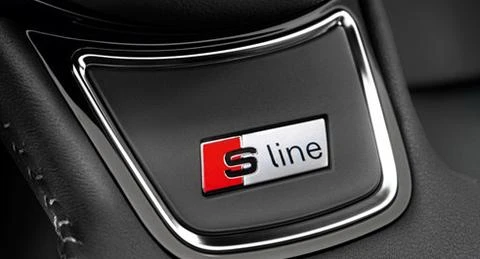
As the three major businesses of Audi quattro, it may be difficult for many people to distinguish Audi S line, Audi S and Audi RS, especially Audi S line and Audi S series. First of all, the “S line” series is the weakest of the three series. It is based on ordinary Audi models and adds some sports kits designed and manufactured by quattro company. Power levels and braking systems are indistinguishable from mainstream production models. The only thing worth mentioning is that the suspension system was adjusted more tough. So don’t confuse it with “S” series or even “RS” series.


The Audi “S” series is an upgraded sports version of Audi’s mainstream production models. It comes standard with an Audi full-time four-wheel drive system and only one high-performance engine (no multiple displacement options), and the “S” The series has greatly improved its sports performance through the replacement of more powerful brake discs and a tougher suspension system. At the same time, these cars are still produced in-line with ordinary Audi models.


The “RS” series is equivalent to the ultimate performance version of ordinary Audi models. Its performance is much higher than the “S” series, and the “RS” series is fully designed, developed and manufactured by Audi’s wholly-owned subsidiary quattro Co., Ltd., and is not produced in-line with ordinary Audi models.


At present, Audi quattro Co., Ltd. has nearly 1,000 employees, of which 450 employees are engaged in production and logistics. The company’s administrative, research and development and production activities are located in Neckarsum, while the sales and marketing operations are integrated at the Audi headquarters in Ingolstadt.


The first RS model developed by Audi quattro was in 1995. The model born at the time was the RS 2 Avant. It is only 17 years since the birth of the Audi RS. And so far, all models born are only RS 2, RS 4, RS 6, TT RS, RS 5 and RS 3. However, the impression that RS has left on people has reached a level of praise.
● Audi’s first four-wheel drive sedan: Audi Quattro (1980-1991)
In 1980, the Audi Quattro, which debuted at the Geneva Motor Show, caused a sensation in the automotive industry, because Audi first applied four-wheel drive technology to civilian cars. At that time, four-wheel drive was still a patent for off-road vehicles, and almost no one ever thought of porting a bulky four-wheel drive system to a civilian car. Audi’s move caused some doubts, so that when Audi decided to bring the Audi Quattro to the rally, they were not objection by other opponents, because they were all waiting to see the joke of this “bulky” German machine.




However, the Audi Quattro rally car soon worked wonders with amazing results. With the two consecutive championships of the World Rally Championship in 1983 and 1984, and the two championships of the team in 1982 and 1984, it allows the world to appreciate the power of four-wheel drive cars.
● Originator of Audi S / RS: Audi Sport Quattro S1 (1985)
In 1985, the Audi Sport Quattro S1 (now called S1 for short) was born. It was born for the WRC Group B race. This car is generally considered the originator of the Audi S / RS. At that time, the car was equipped with an inline 5-cylinder engine with a displacement of 2.2L. The officially announced maximum power is 470 horsepower, but due to the powerful intervention of turbo at high rpm, the actual power can reach 500 horsepower / 8000 rpm.

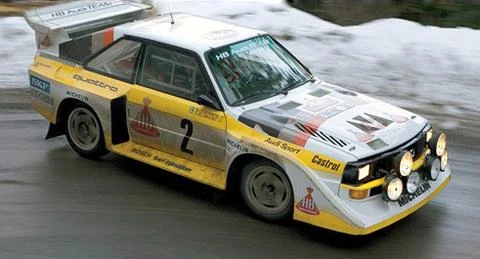




The aerodynamic kit for the entire car is also one of the highlights of the S1. The newly built body weighs only 1090 kg. Such a lightweight body with powerful power output makes the car accelerate from 0-100 km / h in only 3.1 second. What’s more notable is that the “power-shift” gearbox that S1 was equipped with in that time is considered the originator of DSG dual-clutch gearbox today.


Subsequently, Audi used the Sport Quattro S1 to compete in Group B events of the World Rally Championship 1985-1986. In 1985, the Audi Sport Quattro S1 also won the San Remo stage. Then in 1986, due to two accidents of Ford and Lancia in the World Rally Championship Group B, the International Motorsports Committee decided to officially cancel the Group B event, and the Audi Sport Quattro S1 legend came to an end.
● The first RS prototype: Audi S2 (1990-1993)
In 1990, Audi’s first S-series model was born. Audi built the first sports version of the S2 Coupe (two-door four-seater hard-top sedan) with the S logo. The car is equipped with a 2.2L inline 5-cylinder turbocharged engine from the Audi 200. It comes standard with a quattro full-time four-wheel drive system and a 5-speed manual transmission. Maximum power is 217 horsepower.

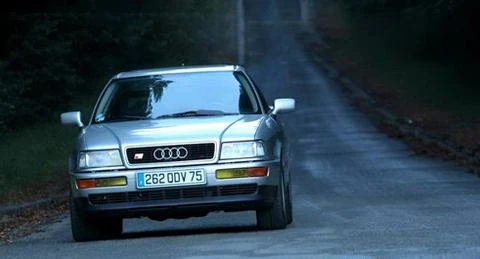
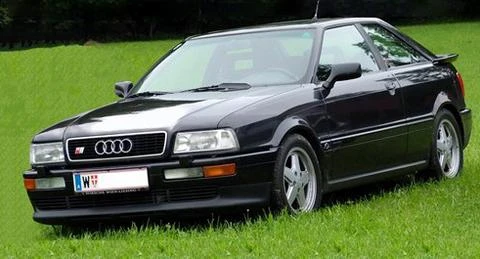
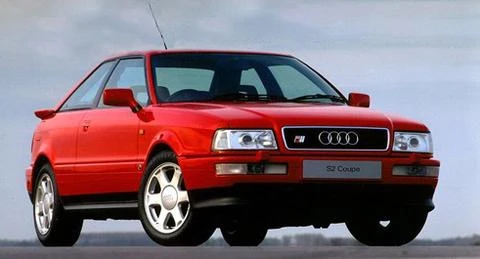
In 1993, the S2 was upgraded, including replacement of new AVUS-style alloy wheels. At the same time, Audi also introduced the S2 Avant (S2 station wagon model) and the limited to 306 units S2 Saloon (four-door sedan version). In fact, both the S2 Avant and S2 Saloon were Built on Volkswagen’s then-new generation B4 platform (S2 Coupe was made on the B3 platform). The masterpiece RS 2 Avant, which was completed by Audi and Porsche, is based on the S2 Avant that manufactured on the B4 platform.


● The first RS model developed with the help by Porsche: Audi RS 2 Avant (1994-1995)
In 1994, BMW launched the classic E36 M3 model, equipped with a super naturally aspirated engine code-named S50B32, with a maximum output of 321 horsepower, becoming the premier high-performance car at the time. In this case, Audi could not hold back, so quattro company later launched a street car that can compete with the M3, that is, the RS 2 Avant, the first model of the RS series.


The first RS model, the RS 2 Avant, was developed in cooperation with Audi and Porsche. Audi provided the basic components, while Porsche was responsible for the overall transformation, including the readjustment of the engine, the complete upgrade of the suspension system and the brake system. Since the car was assembled at Porsche’s famous Rossle-Bau factory, the tires and rearview mirrors were copied directly from the then Porsche 964 Turbo.
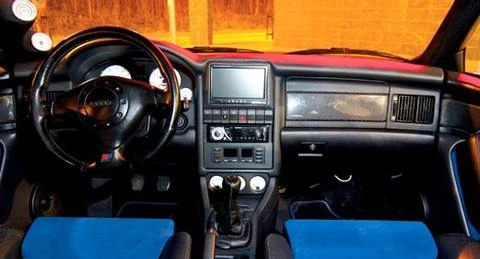



The RS 2 also uses a 2.2L inline 5-cylinder turbocharged engine. At the time, Porsche made further adjustments to this engine, including replacement of large-sized turbines, newly designed camshafts, high-flow fuel injection systems, The Newly written ECU provided by Bosch and the replacement of a larger intercooler, etc. After this adjustment, the output power of RS 2 reached 315 horsepower / 6500 rpm. The peak torque was 410 Nm / 3000 rpm. The 0-100 km / h acceleration in just 4.8 seconds and the top speed is 262 km / h (electronic speed limit).


On the drive system, the RS 2 Avant offers a 6-speed manual transmission. At the same time, the quattro full-time four-wheel drive system based on the Torson mechanical central differential is also standard on the RS 2 Avant. In addition, Porsche also upgrades the brakes and suspension of the RS 2 Avant, and the front and rear brakes used 4-piston calipers made by Brembo.


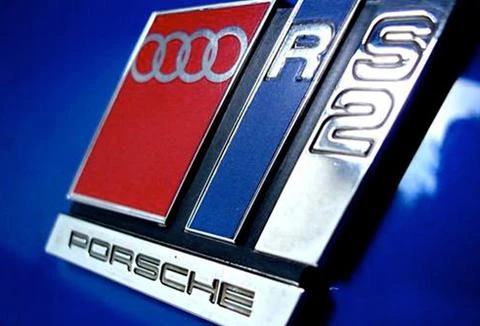
Although the price of the RS 2 is expensive, it is still in short supply. Only 2891 units are produced worldwide. Except for a small amount of export to overseas, most of them are only sold in the European market. However, the car has won an extremely high reputation among fans around the world and firmly established Audi’s position in the high-performance car industry.

